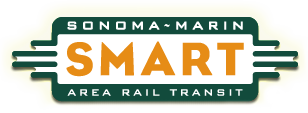Getting people out of cars and into mass transit is good for air quality, may reduce road congestion, and encourages public transportation. These are all good effects, but systems like SMART also affect growth and development patterns. Unless extreme care is taken in the planning and approval process of such development the benefits of mass transit quickly disappear.
One need only look at what’s happened to the East and South Bay served by BART and train service to see how quickly new transportation corridors feed development. BART and CalTrain peninsula systems are now completely congested during commute hours; technical problems strand tens-of-thousands; parking lots are inadequate for the ridership; population in cities and towns along BART’s route are exploding.
The effect of mass transit has been the creation of Megalopolis: massive commuter-driven development stretching from San Francisco east to Concord and south to San Jose. Including some of the fastest-growing cities in California, the Bay Area opted to build commuter routes linking all but the North Bay region together into a multi-modal people-moving system.
Make no mistake about it, moving commuters is good for business, despite the changing reality of the workforce, the internet and the office environment. Freeways and mass transit – paid for with public funds of course – helps private employers maintain a growing labor pool, and facilitates bringing in workers living hours away. This insures that workers are in large supply, at least in theory, which keeps wages lower. In practice, however, mass transit accommodates ever-larger populations which drive up costs of living, especially housing. Thus Megalopolis suffers from all the worst effects of erasing the distinctions between urban and rural areas; in time rural areas will be no more.
The North Bay has been protected by the lack of easy transportation across the Golden Gate. One bridge and sporadic ferry service hinder the movement of workers and the spread of urban development; what some see as a transportation bottleneck can also be viewed as effective rural preservation. Marin opted out of BART before construction began.
When SMART begins to provide service along its Sonoma and Marin corridor, it will logically renew thoughts of building mass-transit extensions across the Golden Gate. If that happens, a ring of mass transit will then circle the entire Bay Area, including the North Bay, from Napa County to Marin and moving south to connect with BART. At that point, Megalopolis will spread its tentacles into the North Bay, consume its rural land and population, and increase the employment pool of the greater Bay Area work force. Industry and development will aggregate along the transportation and mass transit lines so that workers from the South Bay can seek employment in the North.
Santa Clara, Silicon Valley, Dublin, Walnut Creek, Napa, Sonoma, South Marin, San Francisco and the San Jose Peninsula will all meld together into a vast homogenized urban environment. Regional differences will fade away as corporate and industrial architecture establishes a ground-hold. Ultimately, the Bay Area will more resemble Los Angeles and its environs than what we see today. All that will remain of a rural landscape will be those parks and parcels protected as islands within a fully-developed region. This process does not take very long. BART service began merely 40 years ago. Hop a BART train for a tour around its routes and see the future for yourself.
Yes, public transit is smart, but much of what accompanies it is anything but.
